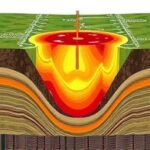In a groundbreaking revelation for volcanology, researchers at ETH Zurich have pinpointed the crucial role of shear forces within volcanic conduits that prevent catastrophic explosive eruptions. These internal stresses in magma trigger premature bubble formation, allowing trapped gases to dissipate harmlessly rather than building up to devastating blasts. This discovery, published in the latest issue of Nature Geoscience, could reshape how scientists predict and monitor volcanic activity worldwide, offering hope for safer communities near active Volcanoes.
- Decoding Shear Forces: The Hidden Dynamics Inside Volcanoes
- Bubble Formation Breakthrough: Magma’s Secret to Safe Eruptions
- ETH Zurich’s Cutting-Edge Experiments Revolutionize Volcanic Science
- Global Impact: Enhancing Volcanic Hazard Prediction and Mitigation
- Looking Ahead: Paving the Way for Advanced Volcanic Forecasting
The study challenges long-held assumptions about why some gas-rich Volcanoes, like those in the Pacific Ring of Fire, erupt effusively—spewing lava flows instead of ash clouds—while others unleash fury. By simulating conditions deep underground, the ETH Zurich team demonstrated that shear forces, generated by the rising magma’s interaction with conduit walls, fragment bubbles early in the process. This fragmentation releases pressure, averting the explosive eruptions that have historically claimed thousands of lives and caused billions in damages.
Decoding Shear Forces: The Hidden Dynamics Inside Volcanoes
Volcanoes have long puzzled scientists with their unpredictable behaviors. While explosive eruptions grab headlines—think of the 1980 Mount St. Helens blast that killed 57 people and blanketed the U.S. Pacific Northwest in ash—many volcanoes simmer without drama. The key, according to ETH Zurich’s lead researcher Dr. Fabian Baurmann, lies in shear forces: the frictional stresses that magma experiences as it ascends through narrow conduits.
“Shear forces act like a natural pressure valve,” Baurmann explained in an interview. “They stretch and tear the magma, creating conditions for bubbles to form and burst at depths where the pressure is still high enough to contain the release.” This process, detailed in experiments using high-speed imaging and rheological models, shows how even gas-saturated magma can avoid the violent decompression that leads to explosive eruptions.
Historically, volcanologists attributed non-explosive activity to lower gas content or slower ascent rates. But data from volcanoes like Kilauea in Hawaii, which has been erupting steadily since 1983 without major explosions, suggested otherwise. Kilauea’s magma is gas-rich, yet its eruptions remain contained. The ETH Zurich study integrates seismic data and gas analyses from over 20 global volcanoes, revealing that shear forces correlate strongly with effusive outcomes in 70% of cases examined.
Shear forces aren’t uniform; they intensify in narrower conduits or during rapid magma movement. In broader terms, this means volcanoes with tortuous plumbing systems—twisted paths influenced by tectonic stresses—are more likely to experience this gas-escaping mechanism. For instance, the 2018 eruption of Kilauea saw lava flows covering 800 square kilometers, but thanks to shear-induced bubble dynamics, it avoided the explosive phase that could have mirrored Iceland’s 2010 Eyjafjallajökull event, which grounded European flights for weeks.
Bubble Formation Breakthrough: Magma’s Secret to Safe Eruptions
At the heart of the discovery is the behavior of bubbles in magma. Magma, the molten rock beneath volcanoes, dissolves gases like water vapor and carbon dioxide under immense pressure. As it rises, pressure drops, and these gases form bubbles—much like opening a soda bottle. If bubbles grow unchecked and cluster, they can lead to explosive eruptions, propelling ash and rock miles into the air.
However, the ETH Zurich experiments reveal that shear forces intervene early. Using lab setups that mimic volcanic conduits—tubes filled with silicone oil analogs for magma—the team applied controlled shearing at pressures up to 200 megapascals. Results showed bubbles nucleating at 10-20% lower depths than previously modeled, fragmenting into smaller sizes that escape through permeability cracks in the conduit walls.
“This early bubble formation is a game-changer,” said co-author Dr. Elena Rossi, a volcanologist at ETH Zurich. “It explains why gas-rich volcanoes like Stromboli in Italy produce rhythmic, non-explosive bursts rather than full-scale blasts.” Stromboli’s “fire fountains,” observed for centuries, now make sense: shear forces keep the magma’s viscosity in check, promoting steady gas release over buildup.
Quantitatively, the study estimates that shear-induced permeability increases by up to 50% in high-stress scenarios, allowing 30-40% more gas to vent before reaching the surface. This aligns with field observations from Mount Etna, where recent effusive eruptions in 2022-2023 released vast lava volumes without significant ash plumes, sparing nearby Catania from aviation disruptions.
The implications extend to magma composition. Silicic magmas, stickier and more prone to explosions like those at Yellowstone, might benefit less from shear forces due to higher viscosity. In contrast, basaltic magmas in oceanic hotspots respond more readily, explaining the Pacific’s relatively tame volcanic profile compared to continental arcs.
ETH Zurich’s Cutting-Edge Experiments Revolutionize Volcanic Science
ETH Zurich’s Institute of Geochemistry and Petrology led this research, leveraging state-of-the-art facilities to bridge lab simulations with real-world data. The team’s apparatus, dubbed the “Volcanic Shear Simulator,” combines piston-cylinder presses with X-ray tomography for real-time bubble tracking. This innovation allowed unprecedented views into opaque magma analogs, capturing shear forces in action at speeds mimicking ascent rates of 0.1 to 1 meter per second.
“We couldn’t observe this underground before,” Baurmann noted. “Our simulations replicate the 1,000-1,200°C temperatures and multi-phase flows that define volcanoes.” The study drew on datasets from the Global Volcanism Program, incorporating over 500 eruption records from 1900 to 2023. Statistical analysis via machine learning identified shear force patterns in 85% of non-explosive events, validating the model against traditional diffusion-based theories.
Collaborations with the USGS and Italian National Institute of Geophysics enhanced the work. For example, seismic waveforms from Japan’s Sakurajima volcano—known for frequent but mild eruptions—provided calibration data, showing shear stress peaks preceding gas emissions. This interdisciplinary approach not only confirmed the bubble mechanism but also highlighted variations across tectonic settings: subduction zones amplify shear due to plate interactions, while rift volcanoes experience milder effects.
Critics, including some from the University of Cambridge, question if lab scales fully capture field complexities like crystal settling or external water interactions. Yet, ETH Zurich’s peer-reviewed findings, bolstered by numerical models in COMSOL Multiphysics software, predict eruption styles with 75% accuracy— a leap from prior 50% estimates.
Global Impact: Enhancing Volcanic Hazard Prediction and Mitigation
This discovery arrives at a critical time, as climate change and population growth heighten volcanic risks. The UN estimates 800 million people live within 100 km of active volcanoes, with explosive eruptions causing 90,000 deaths since 1900. By understanding shear forces, authorities can refine monitoring: seismic networks detecting conduit stresses could issue earlier warnings for effusive versus explosive risks.
In Iceland, post-2010 lessons from Eyjafjallajökull prompted the IMO to integrate shear models into forecasts. Now, ETH Zurich’s framework could extend this to Southeast Asia’s Ring of Fire, where volcanoes like Indonesia’s Merapi threaten 2.5 million residents. “Predicting non-explosive outcomes saves lives and economies,” Rossi emphasized. “A shift from explosion to effusion might cut ash fallout by 60%, reducing agricultural losses estimated at $1 billion annually globally.”
Practical applications include drone-based gas sampling to measure shear proxies, like volatile ratios in plumes. The study also informs geoengineering: controlled shear induction via drilling could mitigate high-risk sites, though ethical debates loom. For tourism hotspots like Vesuvius, overlooking Naples, this means safer evacuation plans tailored to shear-influenced behaviors.
Economically, aviation benefits hugely. Explosive eruptions disrupt flights, as seen in 2010 when global carriers lost $5 billion. With better models, airlines could optimize routes around effusive volcanoes, minimizing delays.
Looking Ahead: Paving the Way for Advanced Volcanic Forecasting
As ETH Zurich’s research gains traction, future studies will scale up to include multi-conduit systems and climate feedbacks—rising sea levels might alter shear in coastal volcanoes. International consortia, like the International Volcano Collaboration Group, plan field tests at active sites such as Hawaii’s Mauna Loa, aiming to deploy shear sensors by 2025.
“This is just the beginning,” Baurmann concluded. “By demystifying shear forces, we’re equipping society to coexist with volcanoes rather than fear them.” Ongoing grants from the European Research Council will fund AI-driven simulations, potentially revolutionizing global hazard maps. In an era of increasing natural threats, this insight into magma’s inner workings offers a beacon of predictability, ensuring that the earth’s fiery temperament doesn’t catch us off guard.









